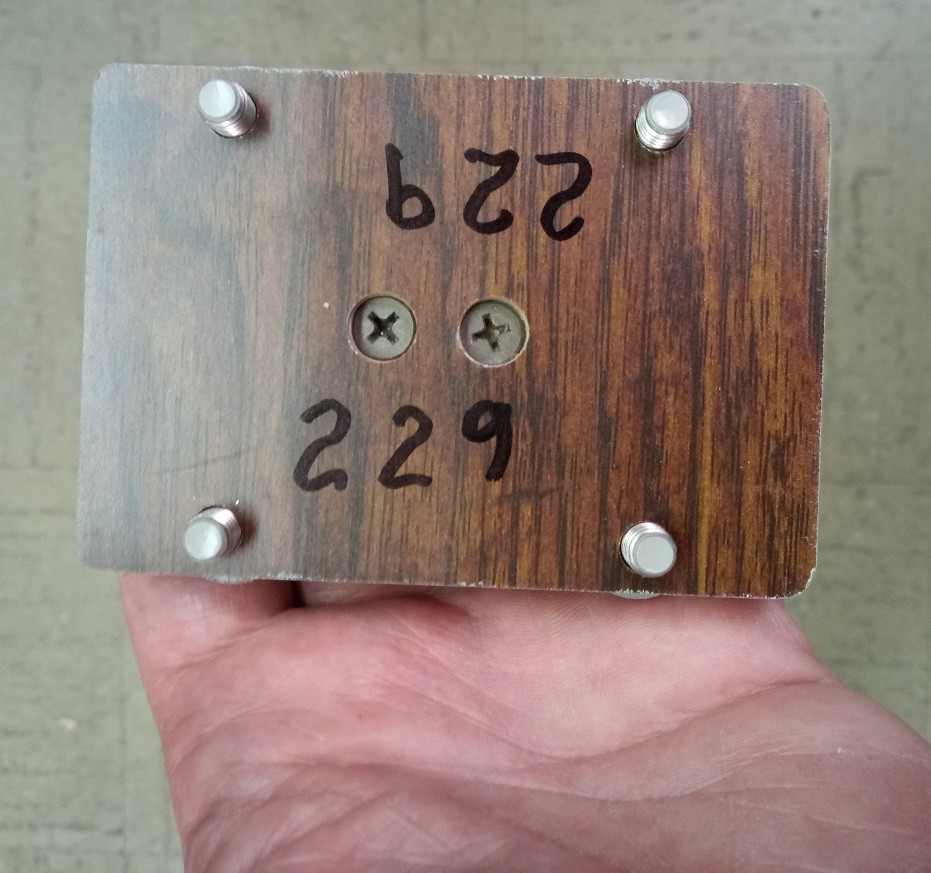I work in an industrial building where they rent space to many different businesses, and our machine shop is right across from the dumpster. We have had a business here that created plywood cabinetry, we have had two different flooring businesses, and we now have a business that makes furniture out of maple, and they discard narrow strips of maple about 8 feet long. They have marveled that I find these pieces about 1.25” max per side useful, but I do. Here is an assortment of wood rescued from the dumpster. I find used flooring with nail holes is still useful for structural builds.

For our company I spray paint small passive microwave devices. We used to fixture them by using 1.25” long screws in the mounting holes, but holding them by such short screws puts my glove into the path of the spray gun, and the paint builds up on my glove. A typical unit will have either an SMA or N female connector on at least 1 port. This is my favorite attachment point for paint fixturing. I’ve scrounged some old SMA or N male connectors for fixturing. Here is a paint stick re-using an old broom handle, and a flanged SMA MALE connector. You can see the paint build up on it. Enamel is tough stuff. I’ve learned to wrap the paint stick and connector in masking tape to make build up removal easier


For wave-guide circulators or isolators, I’ve learned how to make a plate that mounts to the wave-guide flange. Here is a plate for a WR229 size wave-guide circulator. The four mounting holes are through holes sized to fit the appropriate screws, the two holes in the center are countersunk, since the screw heads will be on the side that touches the circulator. They are spaced apart to keep the stick from rotating while I’m painting, but not so far apart that the stick becomes too big to easily handle. I’ve used OpenSCAD to model the plates and Kiri:Moto to generate the G-code to cut them out, but this can easily be done by hand.

I’ve found that my favorite size for the stick is a ¾” square dowel that has been made into an octagon with a router table and a 45 degree chamfer bit, though a 1” broom handle is still quite comfortable in my hand. I find that alternating 9” and 12” sticks allows closer spacing of the units without them swinging into each other.
Here is the plate for a WR42 wave-guide circulator. The holes are smaller because the screws are smaller, and that required thinner material for the plate. ¼” plywood worked here. It was easy to find scrapped ¼” plywood big enough for a few of these, but I coated them with CA glue to make them stronger. The stick was necessarily smaller also, so I used some scrapped maple that was about ¼” by 3/8” in cross section. I’m sure the guys that threw this away will be surprised to hear I’ve found a good use for that!

I have
found that the solid picture hanging wire I acquired is pretty
durable, and even though it bends easily, lasts a long time. I still
prefer to use the .104” thick wire I bought at the Home Depot. It
doesn’t bend, and is strong enough to be trusted. If you can avoid
it, don’t try galvanized wire, the texture is annoying in the hand.


Here are 3 wave-guide isolators
hanging from our rack mounted on the wall. Even the rack was rescued
from the dumpster when a business moved out. Barely noticeable are
the red zip-ties that make hanging the sticks with the right spacing
easy.

Also, if you want to tip a piano up
onto a mover’s dolly without straining your back, or you want to
move that piano upstairs by yourself, again without straining your
back, surplus hardwood flooring can be your friend.


Although I hope to make a page about my piano moving experience, since I mentioned it, I’d like to add a word of caution here.
CAUTION *** Though I made the “A” frame from hardwood flooring, and used a skate bearing sandwiched between 6 fender washers, I found it to be just barely usable. If I do it again, I would either double up on the flooring material, or just use 4x4s instead. The skate bearing race disintegrated 2/3 of the way up, but the inner race finished the job. Next time I’d find a bigger heftier bearing.
 Carl Giles
Carl Giles
Discussions
Become a Hackaday.io Member
Create an account to leave a comment. Already have an account? Log In.